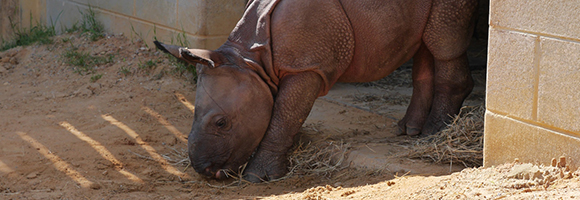Endangered Indian Rhinoceros calf conceived by artifical insemination born at the Montgomery Zoo
The Montgomery Zoo and the Cincinnati Zoo & Botanical Garden’s Center for Conservation & Research of Endangered Wildlife (CREW) are excited to announce the birth of a male Indian rhino calf produced by artificial insemination (AI). This is the first known calf, of any rhino species in the U.S., to be produced by AI and be born and thrive in zoos.
Visit NBCNews.com for , , and

In February 2012, CREW’s Reproductive Physiologist, Dr. Monica Stoops worked in partnership with Montgomery Zoo’s staff to perform a standing sedation AI procedure, inseminating Jeta, the Montgomery Zoo’s 12-year-old female, who is on an extended breeding loan from the San Diego Wild Animal Park, with frozen-thawed semen from the resident male rhino, Himal. Dr. Stoops collected Himal’s sperm in 2004 and stored it at -320°F in CREW’s CryoBioBank in Cincinnati for eight years before it was brought to Alabama, thawed, and used in the AI procedure. The Montgomery Zoo staff monitored Jeta’s pregnancy over the 15-16 month gestation period and on June 5, 2013 she gave birth to a healthy calf. This is the second calf born to Jeta at the Montgomery Zoo and it weighs approximately 90 pounds.
This is a significant birth and scientific achievement for the Montgomery Zoo, CREW and the Zoological Association of America (ZAA) since the Indian rhino is an endangered species. Jeta’s calf demonstrates using AI science, developed by CREW’s Dr. Stoops, as a repeatable and valuable tool to help manage the Indian rhino population in zoos. With only 60 Indian rhinos in zoos in North America and approximately 2,500 remaining in the wild, successful breeding between rhino pairs is important to maintain the genetic diversity necessary to keep a population healthy and self-sustaining. Unfortunately, natural breeding attempts in Indian rhinos in human care frequently result in severe aggression between the male and female. Because of this behavioral incompatibility, genetic management of the Indian rhino is a challenge. Artificial insemination can be used to improve the genetic health of Indian rhinos in human care by infusing genes from non- or under-represented rhinos.
“The staff of the Montgomery Zoo is pleased with the partnership between these two zoos and the outcome of a significant Indian Rhino birth. We encourage the public to come out to the Montgomery Zoo and observe this
calf as he develops.” — Doug Goode, Montgomery Zoo Director
“Everyone at the Cincinnati Zoo and the scientists at CREW are incredibly excited to watch this calf grow up,” said Dr. Stoops. “The scientific significance of the birth and the successful upbringing by Jeta are a lifetime of work in the making. We were honored to work closely with the Montgomery Zoo staff to do the AI and we are proud to help introduce this baby to the world.”

